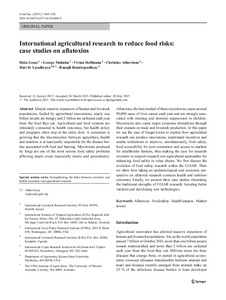| dc.contributor.author | Grace, Delia |
| dc.contributor.author | Mahuku, George S. |
| dc.contributor.author | Hoffmann, V. |
| dc.contributor.author | Atherstone, Christine |
| dc.contributor.author | Upadhyaya, Hari D. |
| dc.contributor.author | Bandyopadhyay, Ranajit |
| dc.date.accessioned | 2019-12-04T10:57:14Z |
| dc.date.available | 2019-12-04T10:57:14Z |
| dc.date.issued | 2015-06-20 |
| dc.identifier.citation | Grace, D., Mahuku, G., Hoffmann, V., Atherstone, C., Upadhyaya, H.D. and Bandyopadhyay, R. 2015. International agricultural research to reduce food risks: Case studies on aflatoxins. Food Security 7(3):569-582. |
| dc.identifier.issn | 1876-4517 (print) |
| dc.identifier.issn | 1876-4525 (online) |
| dc.identifier.uri | https://hdl.handle.net/20.500.12478/661 |
| dc.description.abstract | Despite massive expansion of human and livestock populations, fuelled by agricultural innovations, nearly one billion people are hungry and 2 billion are sickened each year from the food they eat. Agricultural and food systems are intimately connected to health outcomes, but health policy and programs often stop at the clinic door. A consensus is growing that the disconnection between agriculture, health and nutrition is at least partly responsible for the disease burden associated with food and farming. Mycotoxins produced by fungi are one of the most serious food safety problems affecting staple crops (especially maize and groundnuts). Aflatoxins, the best studied of these mycotoxins, cause around 90,000 cases of liver cancer each year and are strongly associated with stunting and immune suppression in children. Mycotoxins also cause major economic disruptions through their impacts on trade and livestock production. In this paper we use the case of fungal toxins to explore how agricultural research can produce innovations, understand incentives and enable institutions to improve, simultaneously, food safety, food accessibility for poor consumers and access to markets for smallholder farmers, thus making the case for research investors to support research into agricultural approaches for enhancing food safety in value chains. We first discuss the evolution of food safety research within the CGIAR. Then we show how taking an epidemiological and economic perspective on aflatoxin research connects health and nutrition outcomes. Finally, we present three case studies illustrating the traditional strengths of CGIAR research: breeding better varieties and developing new technologies. |
| dc.language.iso | en |
| dc.subject | Animal Diseases |
| dc.title | International agricultural research to reduce food risks: Case studies on aflatoxins |
| dc.type | Journal Article |
| dc.description.version | Peer Review |
| cg.contributor.crp | Agriculture for Nutrition and Health |
| cg.contributor.affiliation | International Livestock Research Institute |
| cg.contributor.affiliation | International Institute of Tropical Agriculture |
| cg.contributor.affiliation | International Food Policy Research Institute |
| cg.contributor.affiliation | International Livestock Research Institute |
| cg.contributor.affiliation | International Crops Research Institute for the Semi-Arid Tropics |
| cg.contributor.affiliation | Kansas State University |
| cg.contributor.affiliation | University of Western Australia |
| cg.isijournal | ISI Journal |
| cg.authorship.types | CGIAR and advanced research institute |
| cg.journal | Food Security |
| cg.howpublished | Formally Published |
| cg.accessibilitystatus | Open Access |
| local.dspaceid | 68831 |
| cg.targetaudience | Scientists |
| cg.identifier.doi | https://dx.doi.org/10.1007/s12571-015-0469-2 |

